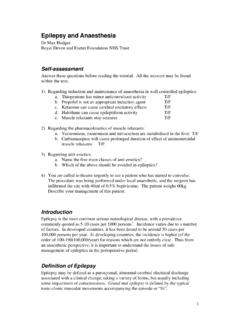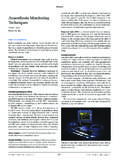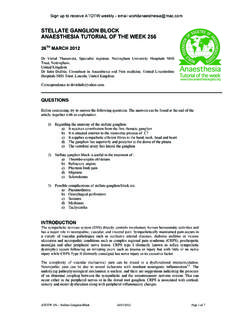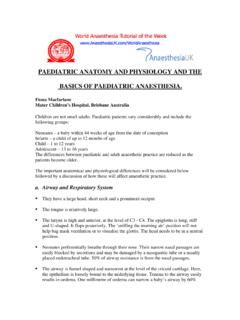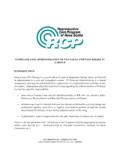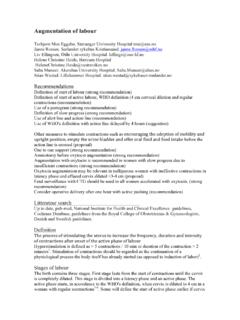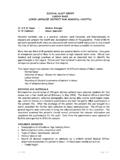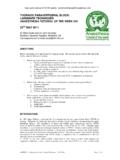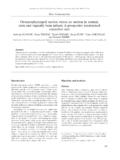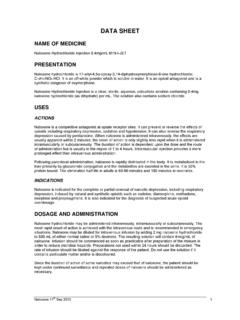Transcription of Analgesia for Labour - Anaesthesia UK
1 Analgesia for Labour Dr Matt Rucklidge Consultant Anaesthetist Royal Devon and Exeter Hospital United Kingdom Key Points There are many different techniques both regional and non-regional to provide Labour Analgesia . Non-regional techniques are the most frequently employed methods for Labour Analgesia . Meperidine (pethidine) is the most frequently used opioid for Labour Analgesia . Its limited efficacy and side effects are well documented. Inhalation of nitrous oxide relieves Labour pain to a significant degree and is especially beneficial in hospitals where other analgesic options are not available. Epidural Analgesia , when compared with other methods, provides superior Analgesia for Labour . There is no association between epidural Analgesia and an increased risk of caesarean delivery or post partum backache.
2 There is an association with prolongation of Labour and increased operative vaginal delivery. Analgesia for Labour Labour may be the most painful experience many women ever encounter. The experience is different for each woman and the different methods chosen to relieve pain depend upon the techniques available locally and the personal choice of the individual. Non-regional techniques for Labour Analgesia Non-regional methods available for Analgesia in Labour may be divided into non-pharmacological and pharmacological methods. Non-pharmacological Methods Advantages of non-pharmacological techniques include their relative ease of administration and minimal side effects; however there is little evidence to support the efficacy of many of these techniques and some may be costly and time consuming.
3 A selection of non-pharmacological techniques are listed below: Transcutaneous electrical nerve stimulation (TENS); see below Relaxation/breathing techniques Temperature modulation: hot or cold packs, water immersion Hypnosis Massage Acupuncture Aromatherapy Transcutaneous electrical nerve stimulation (TENS) Electrodes are placed about 2cm over the T10-L1 dermatomes either side of the spinous processes to provide Analgesia for the first stage of Labour . A second set of electrodes is placed over the S2 S4 dermatomes for second stage pain relief. Women can alter the amount of current supplied to the electrodes providing some degree of control throughout their Labour . Blockade of pain transmission to the brain through stimulation of A-fibre transmission and local release of -endorphins are suggested theories for TENS Analgesia ; however there is no evidence that TENS provides more Analgesia than placebo.
4 Despite this, TENS has minimal side effects and may be appropriate for women who have contraindications to other methods of pain relief or where other methods are not available. Pharmacological agents include inhalational agents and systemic analgesics. Inhalational Methods Nitrous oxide Nitrous oxide has been used in obstetric practice for over a century and a survey in 1990 demonstrated its availability in 99% of UK obstetric units and use by 60 % of parturients. Entonox (50 % nitrous oxide in oxygen) provides Analgesia within 20-30 seconds of inhalation with a maximum effect after about 45 seconds. Advantages include: ease of use no requirement for physician supervision minimal accumulation with intermittent use self-administration provides some control.
5 Disadvantages include: drowsiness, disorientation and nausea may occur including brief episodes of loss of consciousness (observed in of cases after prolonged use) does not provide complete Analgesia . The efficacy of inhaled nitrous oxide for Labour pain has been much debated. Current clinical data suggest it relieves Labour pain to a significant degree in most women but does not provide complete Analgesia for many. Nitrous oxide remains a useful analgesic modality for Labour pain and is especially beneficial in units where other analgesic options are limited. Inhalation of halogenated agents Several volatile anaesthetic agents have been inhaled intermittently for Labour Analgesia . Their use is limited by technical difficulties in their safe administration and scavenging.
6 Systemic analgesics Meperidine (Pethidine) Meperidine is a synthetic phenylpiperidine derivative which is commonly administered intramuscularly (IM) in a dose of 1mg /kg. Despite widespread use, its efficacy has been questioned and it has been suggested that it provides merely sedation rather than Analgesia in Labour . Meperidine, like other opioids, delays gastric emptying and has been shown to increase gastric volumes in Labour . It also causes sedation, dose-dependant respiratory depression and its active metabolite (nor-meperidine) has convulsant properties. Meperidine crosses the placenta and its effects on the fetus are dependant on dose and timing of administration; the highest fetal plasma concentration occurs 2-3 h after maternal IM administration.
7 Neonatal effects are compounded by production of nor-meperidine which causes further sedation and respiratory depression. Babies of women administered meperidine in Labour have been shown to be sleepier, less attentive and less able to establish breast feeding despite normal apgar scores. Despite these disadvantages, Meperidine remains popular in many obstetric units, is easy to administer and may be a useful analgesic modality where other methods are not available or contraindicated. Morphine Morphine shares many of the side effects of meperidine and rapidly crosses the placenta, however its metabolites do not have convulsant effects. The dose used for maternal Analgesia is Diamorphine Diamorphine, a more potent drug than meperidine, is increasingly used for Labour Analgesia in the UK though is currently under threat by problems of supply.
8 It is administered intramuscularly in the dose of Fentanyl Fentanyl, a highly potent phenylpiperidine derivative, has a rapid onset of action. It has a longer terminal half life than both meperidine and morphine and repeated dosing may result in drug accumulation in both the fetus and the mother. Advantages include absence of active metabolites and rapid onset of action making it useful for patient-controlled Analgesia . Patient-controlled Analgesia (PCA) If regional Analgesia is unavailable or contraindicated, then PCA is a useful method of pain control as long as the equipment and staffing are available. PCA provides some control to the woman, and this in itself is associated with greater satisfaction; however it is important that women are instructed in how to use the device effectively.
9 Many opioids have been used in PCA devices; drugs currently used include fentanyl and more recently remifentanil. A suggested regimen for fentanyl PCA is 20 g bolus with 5 min lockout; however the ideal loading dose, bolus dose, lockout time and maximum hourly dose remain unclear. Both parturient and neonate should be carefully monitored during Labour and post-partum and PCA settings altered accordingly. Remifentanil, an ultra short acting opioid, is rapidly hydrolysed by blood and tissue esterases and does not accumulate even after prolonged infusions. There are increasing reports of its use in PCA though like fentanyl, the ideal regimen remains unclear. A bolus dose of g Kg-1 with 2 minute lock-out has been used successfully.
10 However, close monitoring is essential and supplementary oxygen may be required. Regional techniques for Labour Analgesia Regional techniques represent the gold standard for Labour Analgesia . Caudal Analgesia Since the development of epidural catheters, caudal epidural injections have become a less popular technique for Labour Analgesia . Not only do they provide less effective and less flexible Analgesia than lumbar epidurals, there is also a higher risk of inadvertent IV injection. Lumbar Epidural Analgesia Epidural Analgesia effectively relieves Labour pain; however controversy exists as to the effect of epidurals on the progress of Labour , mode of delivery and effects on the fetus and neonate. 1. Effect on caesarean section rate Numerous studies have attempted to establish the influence of epidural Analgesia on progress of Labour and method of delivery.

